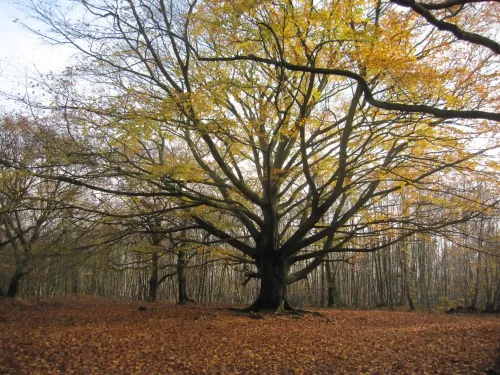
Meet the enchanting heath fritillary butterfly
This rare butterfly relies on wild woodlands - learn more & support its future.

The hedge follows the many bends of the lane – or does it? Actually the lane follows the hedge. The many shrub and tree species in the hedge and remnants of wood anemones and dog’s mercury at its feet indicate a piece of woodland which many years ago became the margin of a field when the rest of the woodland was assarted (felled for agriculture). The number of different trees and shrubs that make up the hedge reinforces its origins.
For hundreds of years, country people have foraged in the hedge for food and medicine. Ancient laws like Hedge Bote and Fire Bote were grants to tenants to gather small wood from hedges for certain purposes (e.g home fires). However, the odd timber trees which were allowed to grow up at intervals were strictly for the wealthy landowner.
We note other species as we wander along: Hazel, the catkins are long gone but with the promise of autumn nuts. Dogwood, branches once used for skewers, with beautifully curved leaves which will turn crimson in autumn are now covered in white flowers. Elder, needs no introduction, sweetest of blossom, perfect for home-made cordial - we see speckled with tiny flies, and then spot a lurking red-headed Cardinal Beetle preying on them. Native woodland trees, Oak, Ash and Field Maple, cut back in their prime, still flourish in ‘bonsai’ form within the hedgerow complex.
We stop and listen to a thin wheezy sound coming from a branch which pokes in an ungainly fashion up from the hedge line – “a little bit of bread and no cheeeeeeese”! And sure enough, a little brightly coloured yellow and chestnut Yellowhammer repeats his song “a little bit of bread and no cheeeese”.
We now see many families taking their daily exercise around this area. We hope they will come to love the treasures of the hedgerow as we have.

This rare butterfly relies on wild woodlands - learn more & support its future.

"As a Blue Mentor at St Radigund’s Youth Club, I’ve watched young people transform curiosity into action, exploring wildlife, local heritage, and historic sites through the pilot Blue Influencers Project. From boat safaris to hidden chambers at Western…

Natasha Ruskin explores something terrifying: a world without woodlands.